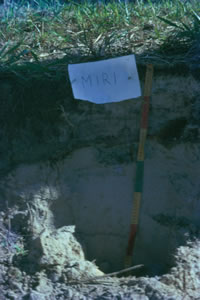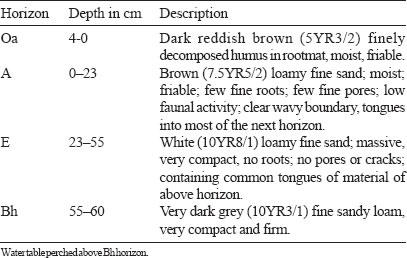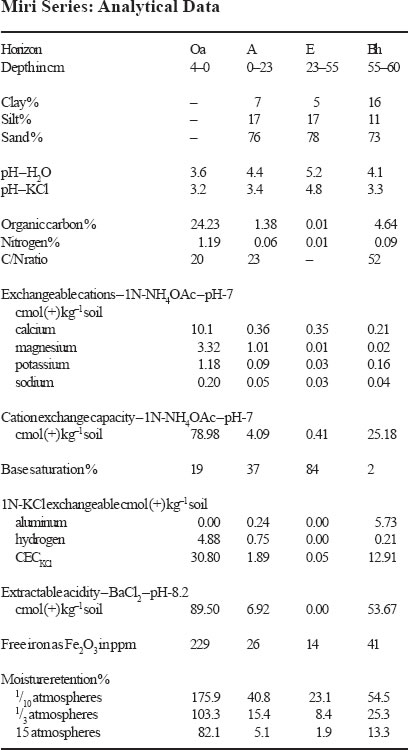Soil Profiles: Miri
Miri Series
The Miri Series is a member of the Miri Family which is a sandy, isohyperthermic, strongly cemented Tipik (Jelik) Tempahumits. It typifies this family and is developed over non-accreting Pleistocene terraces. Soils of the Miri Series are characterized by the presence of an albic horizon and a thick spodic horizon. The spodic horizon which has its upper boundary between 50 to 100 cm of the soil surface is strongly cemented and has a chroma of less than 3 in more than 50% of its thickness. Often due to the cemented spodic horizon a perched water table occurs above it making the soil imperfectly to well drained depending on the depth at which the cemented spodic is encountered.
Type Location
Soils of the Miri Series were probably first established in Sarawak by Andriesse (1972). The above pedon was described by Lim Chin Pang for the CLAMATROPS TOUR II organised by the Malaysian Society of Soil Science in 1977. The pedon was located on a level terrain over High Level Pleistocene Alluvium at the end of the north Pan Road, near the Old Kuching Airport at an elevation of 20 metres (60 feet). The vegetation consists of old secondary pole-like trees. Location: Topographic Sheet 1/110/10, 1°28’50” N, 110°20’00” E (Grid Reference 1/110/10 – 368634 m).
Range in Characteristics
Little is known about the range in characteristics of the Miri Series. As redefined here soils of the Miri Series should only be developed over Older Alluvial terraces. The soil must have a spodic horizon which has its upper boundary between 50 to 100 cm of the mineral soil surface. The spodic horizon must be strongly cemented and have a chroma of 3 or less indicating that it is humus-rich. Due to the strongly cemented spodic horizon the soil has a perched water table below 50 cm making it somewhat imperfectly to well drained. This however depends on the depth at which the spodic is encountered and the time of the year the soil is described.
Competing Soils and Their Differences
The Miri Series, having a spodic horizon, is only likely to be confused with other soils with a spodic horizon. As defined here, the Miri Series is developed over Old Alluvium or Non-accreting alluvium and not over residuum or over beach ridges. They thus occur at elevations above 16 m (50 feet) on gently undulating to level terraces. Often at depth, rounded pebbles may be encountered. Secondly soils of the Miri Series have a strongly cemented spodic horizon which has a chroma – 3 in more than 50% of the spodic and the top of the spodic horizon is encountered between 50 to 100 cm depth. Only two other soils with a spodic horizon at 50 to 100 cm occur over non-accreting alluvium. The Karamatoi Series is similar to the Miri Series but has a spodic horizon that is weakly or non-cemented. The Silimpopon series which has a spodic horizon at 50 to 100 cm which is strongly cemented but the spodic horizon has a colour that has a chroma of greater than 3 i.e. iron-rich. Soils of the Rudua Series (strongly cemented) occur over beach ridges while soils of the Bako Series occur over sedimentary rocks.
Setting
Soils of the Miri Series typically occur on undulating to level terrain (slopes of 0–12% or 0–6°) on Older Alluvium or Raised Terraces at elevations of more than 16 m (50 feet) but often less than 50 m (150 feet).
Principal Associated Soils
Soils of the Miri Series are commonly associated with soils of the Karamatoi Series (weakly cemented spodic) and the Buso Series (spodic < 50 cm and weakly cemented). All these soils have a humus rich spodic horizon. Where iron contents increase they may be associated with soils of the Silimpopon series (iron-rich, cemented spodic).
Drainage and Permeability
Drainage to the top of the spodic horizon is good to excessive. The cemented spodic results in a perched water table above it. Permeability to the spodic horizon is good. Water can stagnate during the rainy seasons but the soil can be dry in the dry season.
Use and Vegetation
Due to the sandy textures and drainage problems (excessive to poor) most of the areas have a very poor kerangas forest or secondary vegetation. Many areas have been burnt during the dry season leaving only secondary growth and imperata species.
Distribution and Extent
To-date soils of the Miri Series have only been mapped in Sarawak but they are also expected to be present in Sabah.
Series Established
Originally the Miri Series was defined over beach ridges and then extended to cover soils with a spodic horizon on terraces. As defined here they are now only confined to raised terraces. The series was established by Andriesse (1972). The source of name is Miri town in Sarawak.
Remarks on Classification
The Miri Series is classified here according to the Malaysian Soil Taxonomy – Second Approximation (Paramananthan 1998) as a member of the sandy, siliceous, strongly cemented, isohyperthermic family of Tipik (Jelik) Tempahumits developed over old terraces. They are classified here as soils having a humus rich cemented spodic horizon (chroma – 3) at a depth of between 50 to 100 cm. These soils are developed over old terraces but not over beach ridges. Drainage in these soils is imperfect to well drained. In the Keys to Soil Taxonomy – Eighth Edition (Soil Survey Staff 1998), soils of the Miri Series are probably classified as an Oxyaquic Haplorthods because the spodic horizon has less than 6% organic carbon and the soil has a perched water table around 60 cm. In the FAO/UNESCO Soil Map of World – Revised Legend (FAO 1990) soils of the Miri Series are probably Haplic Podzols.
Suitability for Agriculture
Due to their sandy textures and very poor fertility status, soils of the Miri Series are not suitable for agriculture and are best left under their natural vegetation. However care must be taken to prevent fires during the dry season.



